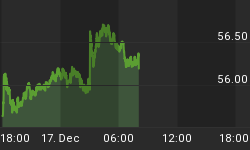The US trade deficit rose 0.8% to $63.4 billion in May from a revised $63.3 billion (initial $63.4 billion) in April. Exports rose 2.4% to $118.7 bln while imports rose 1.8% to $182.5 bln.
Due to record high unit price paid for crude oil, imports of petroleum products and crude oil soared 17% and 20% to a record $27.9 bln and $20 bln respectively. But the exports story had a key role in offsetting soaring oil imports. The 2.4% rise in exports beat the monthly average of 0.9% over the past year, producing the highest monthly percentage rise since December 2004.
Notably, the bilateral trade deficit with key trading partners rose for the most part, with the exception of Canada and Japan, against which the deficit fell 8% and 6% respectively. The trade gap with China rose 4% to $17.7 bln from April and 12% from May of last year. The deific with the Eurozone and the UK increased 16% and 40% respectively from April.
Shaky Geopolitics Destabilize Dollar-Gold Relationship
Despite the resulting rally in the dollar, gold prices rose to a 6 week high of $655.30 per ounce, as geopolitical conditions took a turn to the worse, when Israeli soldiers raided Southern Lebanon for the first time since withdrawing in 2000. The assaults occurred one day after a series of bombings killed 200 people in India. The week began with staunch declarations from Japan vowing to take action against North Korea, before China assumed the lead in directing talks with the North Korean government. The standoff over Iran's nuclear technology may have temporarily stabilized for now, but the armed return of Hizbullah into the Israeli-Palestinian confrontations could culminate into an escalation of vengeful attacks against civilians in Israel, Lebanon and Palestine.
Instead of posing direct threat to the US dollar, the deteriorating geopolitical situation helps stabilize the Swiss franc and precious metals against interest rate-driven optimism in the US dollar. The safe haven argument favoring the franc could extend into the other low interest rate currency -- the Japanese yen -- as the Bank of Japan joins the Swiss National Bank in tightening monetary policies. Consequently, the unwinding of carry trades could manifest into a rising yen, Swiss franc at the expense of the US dollar towards the end of the quarter.
In the short term, any dollar downside would be limited by next month's impending Fed hike. The deepening inversion in the US yield curve augurs well for the US currency since it reflects rising probability of a Fed move next month. With 10-year yields at 5.11% and 2 year yields at 5.18%, the inversion is at its deepest since March 1st. The chart below shows a strong positive correlation between the falling EUR/USD exchange rate and the 10-2 year yield differential. Hints on next month's Fed meeting will be obtained from next week's Congressional testimony by Fed Chairman Bernanke and the release of the June FOMC minutes, both of which we expect to maintain the Fed's anti-inflation concerns and maintain a floor for the greenback.

After some rumors indicated that the Bank of Japan would make a smaller than expected rate hike of only 15 bps in its overnight call rate, media reports indicate that the central bank will raise the target by 25 bps to 0.25% and the lift the symbolic discount rate to 0.4-0.5% from the current 0.1%. Considering the extreme cautiousness adopted by Japanese government officials towards any excessive increase in long bond yields and the currency, we see more downside risks in USDJPY leading to the Friday decision rather than after it. Although Japan's government officials are expected to hit the wires on Friday cautioning against the risk of fast appreciation in long term rates, the Japanese currency is likely to gain some ground in anticipation of the central bank decision. But cautiousness ahead of Friday's US data and the North Korea crises; the pair has remains well supported at 114.50 and 113.80.















